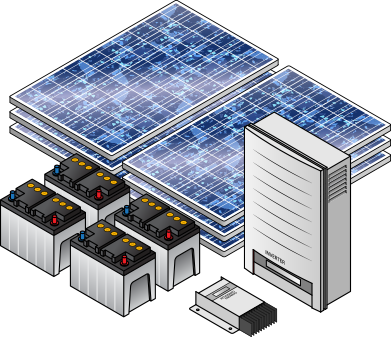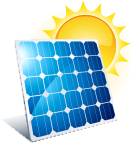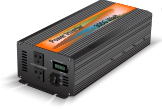It doesn’t take an electrical engineer to start generating electrical power using solar kits. Solar kits range in size from small devices designed to charge your cell phone to rooftop panels you can use to power your home. Kits contain all or most of the parts you need and vary in price from $50 to tens of thousands of dollars. You can get your start with solar using a kit and most of the larger, more costly kits will allow you to expand your system by adding panels later. This page will help you understand the parts most kits include, give you the pros and cons of solar kits, and help you understand the range of kits available today.
Is a Solar Kit Right For You?
Generating solar power is more than just slapping a dozen panels on roof and calling it a day. If you don’t know a solar expert, follow this decision tree to learn if you should consider buying a solar kit.
Pros & Cons of Solar Power Kits
The average cost of home solar systems is about $18,000. Of that amount, design and installation labor costs make up about 10 percent of the total bill. A do-it-yourself kit might help you avoid those costs — but beware of possible pitfalls and explore the pros and cons of solar kits.
As mentioned above, about $1 out of every $10 spent on a home solar system goes to design and installation costs. If you’re handy with tools and can calculate how much energy your system needs to produce, designing and installing a solar system might be a smart choice.
Satisfaction of DIY installationFor some homeowners, there’s nothing better than planning, working on, and looking back on a completed project. Installing a solar kit hits all of the right buttons for a DIY project, including saving money on an electric bill every month.
Easy upgradabilityMany who start with solar see the savings first-hand. After weighing the cost and calculating the break-even point, they expand their systems. Most solar kits offer the option of adding panels later to increase their power-generating capacity.
Boost your home’s valueGenerally, solar systems boost home values. However, buyers may be suspicious of an amateur-installed system. Retain all of your building permits and documentation relating to grid hookup approval to show buyers you did it right.

Solar installation requires carpentry and electrician skills, which not all homeowners have. Both are great to know, but tackling a more down-to-earth project as a first project might be a smarter choice with fewer consequences if you fail.
No recourse if you make a mistakeThe consequences of making a mistake when wiring DC circuits can be expensive. One advantage of hiring a professional installer is that if the installer makes a mistake the installer pays for it. If you fry a charge controller because you wired it backward, you pay for a new one.
Warranty claims may not be possibleSome manufacturers require a professional install their equipment to honor their warranties
Comprehend your county building codesYou must be fully versed in your county’s building codes to install panels in compliance with your local rules. For example, you may need a building permit.
Get approval from your utilityUtilities usually require a licensed or otherwise certified electrician to connect a system to the grid. Many utilities have other requirements, too, and it’s up to you to know what these are before making the connection.
Local installers understand local incentivesLocal installers might help you save money or increase your tax benefit by finding a local incentive you may have missed.
Some kits are incompleteSome kits include everything you need, down to the wiring and nuts & bolts. Others don’t include the mounting hardware, wiring, or an inverter. Shop carefully.
What’s in Solar Panel Kits
Complete kits contain most or all of these six basic parts:

|

|

|

|

|

|
|---|---|---|---|---|---|
| Panels | Controller For Battery Systems | Inverter | Batteries | Mounting Hardware | Wiring and Connectivity |
| Solar panels come in different sizes and use different cell technologies. Big-box retailers offering panels sell kits with panels in the 100-watt range. Online solar dealers offer bigger panels – 200 to 300 watts – if you want to handle and install fewer panels. See this LetsGoSolar page to learn more about your panel choices. | You need a charge controller if you will connect your solar panels to batteries, such as in an RV system. You do not need a charge controller if you plan to connect to the local utility grid, which is called a “grid-tie” system. Charge controllers prevent a solar system from over-charging batteries. They come in different capacities and use different technologies affecting efficiency. Visit how solar panels LetsGoSolar page. | Solar panels create DC voltage (think of a car battery or how a flashlight works. Inverters convert DC voltage into AC voltage like what you find in a wall outlet. Inverters come in different capacities and use different technologies, which affects their efficiency. Even the best inverters waste energy during the energy conversion process, which is one reason why you may need to buy more panels than you think. See the Complete Systems LetsGoSolar page. | In home-based systems, batteries are an option. If you want to live off the grid, or are installing a solar system in an RV, then your battery choice is crucial. Very few kits include batteries. You need to send your panels’ power somewhere, be it a battery or to an electrical grid, or a combination of the two. See the Battery LetsGoSolar page to learn more about your choices in solar batteries. | Some kits contain hardware to mount panels to a roof. The challenge for kit sellers is some kit buyers mount panels on their homes, and others mount them on RVs, and some don’t install them on roofs at all. Read the fine print to learn what, if any mounting hardware your kit includes. See this LetsGoSolar page to learn more. | Some kits contain wiring and grid-tie equipment a licensed electrician must install. Most do not because installations are not standard. If you’re considering a kit that contains wiring and connectivity parts, make sure you can use them. |
| Pro tip: The industry benchmark for solar panels is cost per watt. Generally, a lower cost per watt is better, but panel efficiency and warranty comes into the equation. | Pro tip: You get what you pay for in charge controllers. More expensive controllers, called MPPW controllers, are worth the cost for larger systems. | Pro tip: If you’re building a battery-based system, be sure to buy a “pure sine wave” inverter, which mimics the power utilities send us. Watch for efficiency and warranty length | Pro tip: Most homeowners grid-tie alone. Batteries are expensive, and the life of batteries is short (5 years or so). Avoid batteries unless you’re off-grid or live with unreliable power | Pro tip: You have several options for installing solar panels on either a residential roof or an RV’s roof. Hire an installer if you have a tile roof, or if the pitch is steep. | Pro tip: Unless you’re an electrician, you’ll probably underestimate the amount of wire you will need. Do not attempt to connect a system to your home’s power center yourself. Hire an electrician who can certify the work. |
Solar Panel Kits Shopping Guide
Before you start shopping for a kit, look hard at what you hope to accomplish with your solar system. You probably fall into one these three categories.
-
Live off the grid
-
Stay on the grid and cut your electric bill
-
Power something small that’s off-grid, such an RV
The more ambitious your plans, the more planning you will need, and the more you must understand about available products. Study the kits in the table below to understand the range available. By no means is this table complete. Most online solar dealers will work with you to mix and match parts to build the system that matches your needs.
| Solar Panel Kit Name | Panel Watts | Charge Controller Features | Inverter Features | Hardware & Wire | Other Features | Sellers | Price |
|---|---|---|---|---|---|---|---|
Grape Solar Model # GS-200-KIT

|
200 | 35 amp Xantrex C35 charge controller | 450-watt Xantrex inverter | Wire included | none | Costco, Home Depot, Lowes | $300 |
Renogy 100 Watts 12 Volts Monocrystalline Solar Starter Kit

|
100 | Renogy Wanderer 30A PWM Charge Controller | none included | Includes wire and panel mounts | Options to upgrade controller to more efficient models | Renogy.com, Amazon.com | $200 |
Solar Panel Pack 180

|
180 watts | 12A MPPT | None. Designed to work with Aspect Solar generators | Included | Portable use. Folds into included carrying case | Aspect Solar | $1,159 |
On-the-Go Portable 50 Watt Solar Charging Kit

|
50 watt | None | None | None | Handy stand-mounted design designed to fold. | Earth Tech Products | $300 |
2000 Watt DIY Solar Install Kit w/Microinverters

|
2,000 watt | APSystems YC500A micro inverters | None | Separate options | Seller offers financing | Go Green Solar | $4,645 |
Most do-it-yourself kits tend to be less than 1,000 watts in generating capacity. Go Green Solar and Wholesale Solar offer do-it-yourself kits of up to 10 kilowatts in size. If you cannot find a kit that matches your needs, contact Wholesale Solar, Go Green Solar, or Northern Arizona Wind & Sun with your specifications to get a quote on a custom kit.
Resources
-
What are the Pros and Cons of DIY Solar? Breaks down the top pros and cons you need to know about DIY solar before making a decision.
-
Pros and cons of buying DIY solar panels Discusses what the site believes are the two viable ways to install DIY solar panels.
-
Pros and Cons of DIY Solar Panels Focuses on the viability of DIY panels, and concludes making your own panels is not worth the effort. See this LetsGoSolar page to learn how to make your own solar panels.
-
Can I Install Solar Panels Myself? Recommends knowledgeable homeowners design and install solar panels, and leave the electrical connections and grid-tie work to an electrician.






